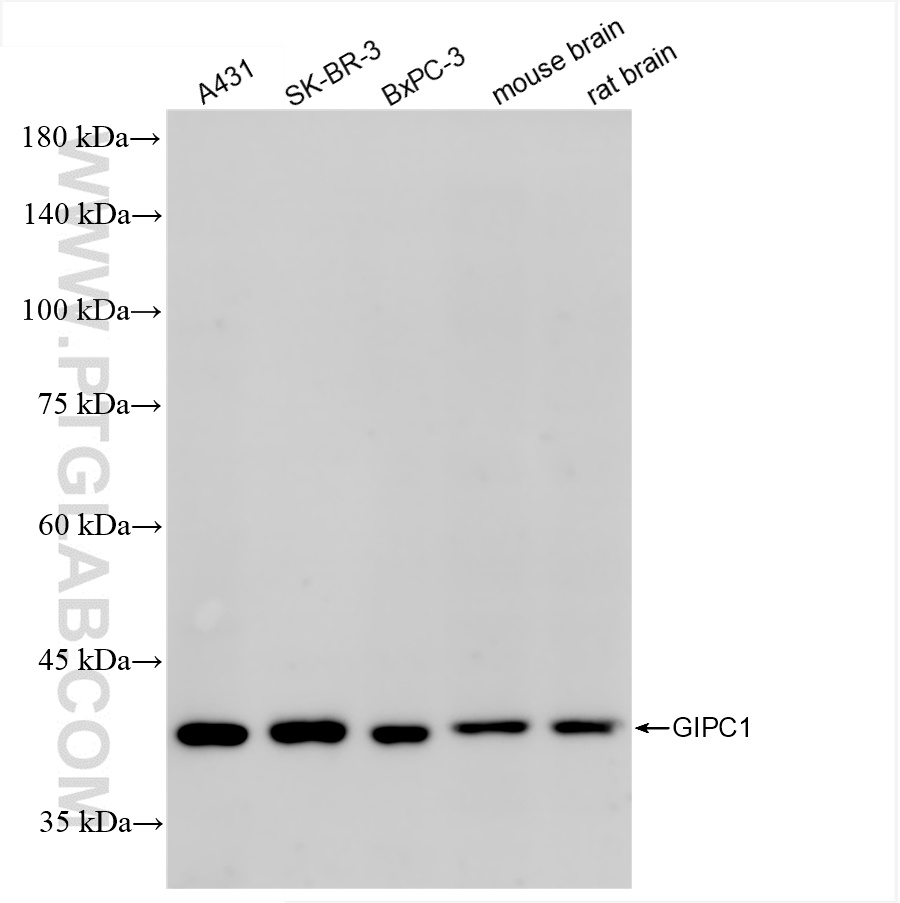验证数据展示
经过测试的应用
| Positive WB detected in | A431 cells, SK-BR-3 cells, BxPC-3 cells, mouse brain tissue, rat brain tissue |
推荐稀释比
| 应用 | 推荐稀释比 |
|---|---|
| Western Blot (WB) | WB : 1:2000-1:10000 |
| It is recommended that this reagent should be titrated in each testing system to obtain optimal results. | |
| Sample-dependent, Check data in validation data gallery. | |
产品信息
86030-1-RR targets GIPC1 in WB, ELISA applications and shows reactivity with human, mouse, rat samples.
| 经测试应用 | WB, ELISA Application Description |
| 经测试反应性 | human, mouse, rat |
| 免疫原 | GIPC1 fusion protein Ag6597 种属同源性预测 |
| 宿主/亚型 | Rabbit / IgG |
| 抗体类别 | Recombinant |
| 产品类型 | Antibody |
| 全称 | GIPC PDZ domain containing family, member 1 |
| 别名 | C19orf3, GAIP C-terminus-interacting protein, GIPC, PDZ domain-containing protein GIPC1, RGS19-interacting protein 1 |
| 计算分子量 | 36 kDa |
| 观测分子量 | 42 kDa |
| GenBank蛋白编号 | BC000410 |
| 基因名称 | GIPC1 |
| Gene ID (NCBI) | 10755 |
| 偶联类型 | Unconjugated |
| 形式 | Liquid |
| 纯化方式 | Protein A purification |
| UNIPROT ID | O14908 |
| 储存缓冲液 | PBS with 0.02% sodium azide and 50% glycerol, pH 7.3. |
| 储存条件 | Store at -20°C. Stable for one year after shipment. Aliquoting is unnecessary for -20oC storage. |
背景介绍
GAIP interacting protein C terminus, member 1(GIPC1), also known as PDZ domain-containing protein GIPC1, is a cytoplasmic protein that also localizes to the peripheral membrane, acting as an adaptor protein linking receptor interactions to intracellular signaling pathways, including cell cycle regulation, and expression has been associated with some cancers (PMID: 19175293, 26757732). This antibody is specific to GIPC1 with a band at 42 kDa (PMID: 18721486).
实验方案
| Product Specific Protocols | |
|---|---|
| WB protocol for GIPC1 antibody 86030-1-RR | Download protocol |
| Standard Protocols | |
|---|---|
| Click here to view our Standard Protocols |
